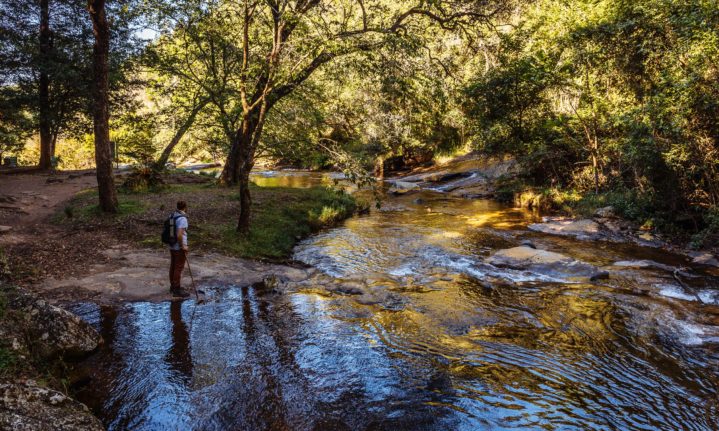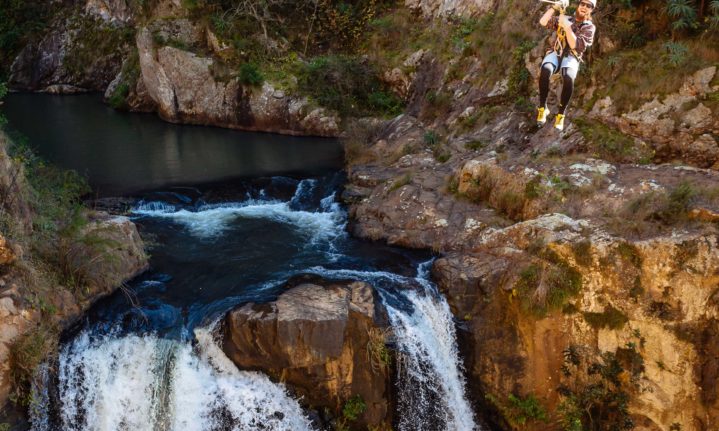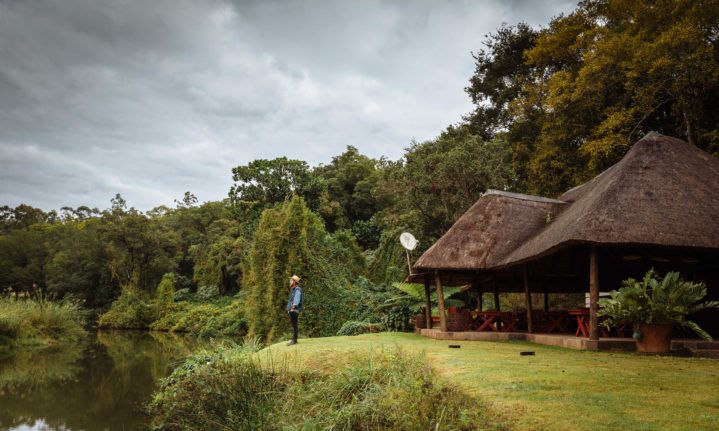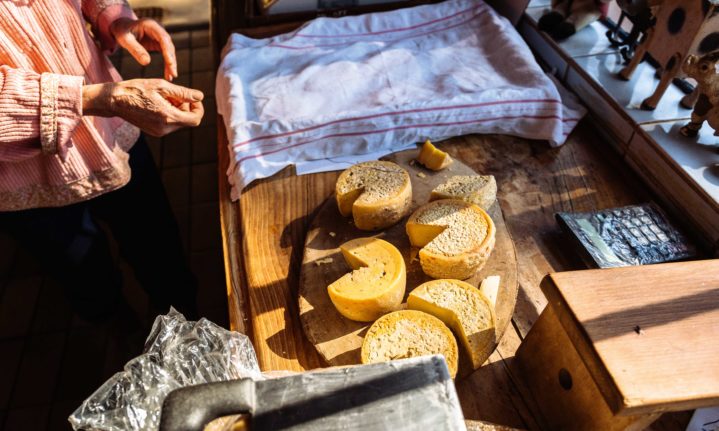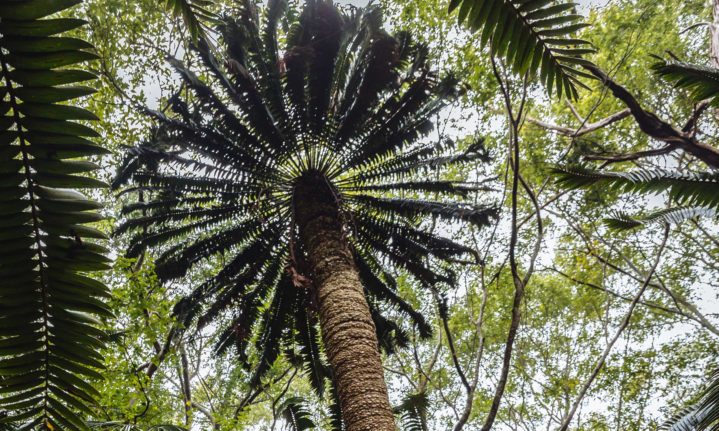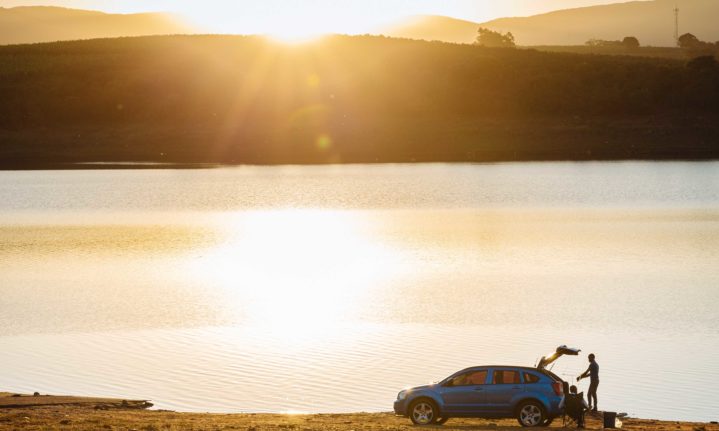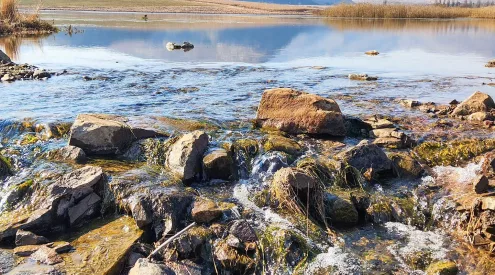Set on fertile ground on the banks of the Great Letaba River, Tzaneenis known as the country’s fruit basket. Mia Louw gets a taste of its abundance.
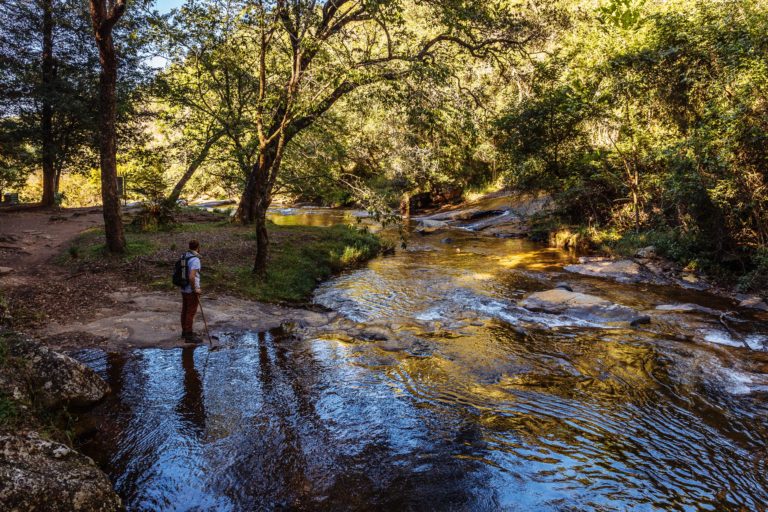
Before reaching Tzaneen, the icy waters of the Politsi River cascade down Debengeni Falls, which means ‘Place of the Big Pot’. Image credit: Mia Louw
The true meaning is basket,’ Andre Thomas replied when I asked him about his hometown’s name. ‘It comes from the Northern Sotho word tsana, and it’s pretty obvious when you look at the location – Tzaneen lies nestled in a hamper of hills.’
We were tucked away on a secluded patio at the Fairview Hotel; Marinda had ordered us a bottle of red wine while we watched the monkeys playing in the canopy above. Andre knows a lot about Tzaneen’s name. As a lawyer, he was involved in an interdict against its proposed name change to Mark Shope in the early 2000s. The lawsuit came to a halt with a march supported by folks from all walks of life who gathered to keep a name which isn’t completely African, nor European, but a mixture of both (possibly due to a spelling error).
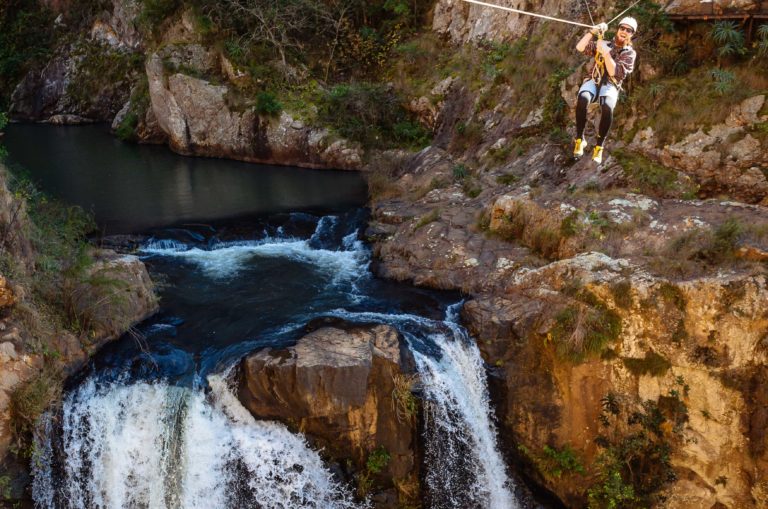
Hook up with friendly guides at Magoebaskloof Adventures for a canopy tour through indigenous forest and over gushing waterfalls. Image credit: Mia Louw
The town isn’t only known for its beautiful basket of mountains, but is also a prolific producer of fruit and veg. With its subtropical climate and good rainfall, the Tzaneen area is responsible for most of SA’s tomatoes, avocados and mangoes; the well-known ZZ2 farming enterprise produces 45 per cent of our tomatoes. Due to the area’s agriculture, more people live in a 30-kilometre radius around Tzaneen than in the town itself.
Another prominent industry is wood production, with around 40 000 hectares dedicated to forestry. Some of the world’s largest planted trees can be found in the Woodbush Forest Estate. One of the Magoebaskloof Giants – a saligna gum planted in 1906 – is 81,5 metres tall. These goliaths are protected under the National Forests Act and are part of the Champion Trees Project, an initiative driven by the Department of Agriculture, Forestry and Fisheries.
Amorentia Estate & Nursery, which specialises in sweet dragon fruit, macadamias, avos and ornamental flowers, is also home to the Three Queens – the largest matumi trees in South Africa.
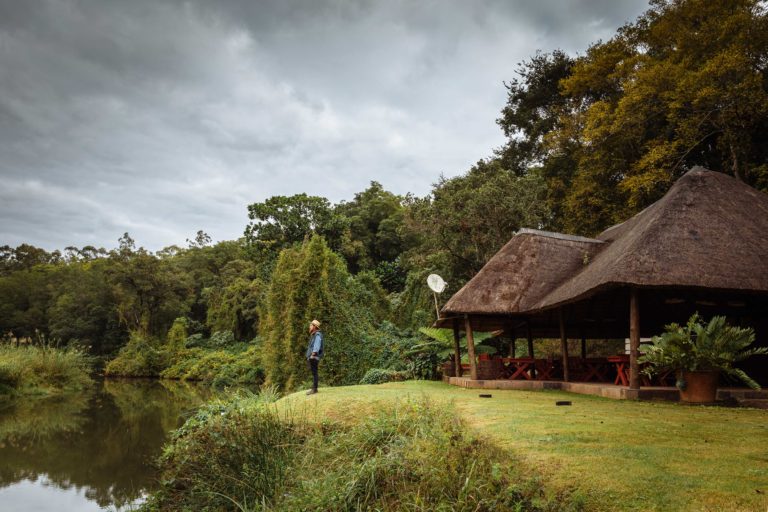
The Fairview Collection lies on the banks of the Great Letaba River. Image credit: Mia Louw
‘Listen … that’s the Knysna turaco calling,’ general manager Wynand Espach said softly, as we strolled into the shade of one. When Wynand met a team of tree climbers in 2013, they started a research and conservation project called Explore Trees. Volunteers spend their nights high up in the branches of these titans, using tree tents to sleep safely and soundly.
One of the projects involves the endangered Cape parrot and some pesky (yet, essential) insects. These birds are not reproducing as they should because the matumi trees don’t have enough cavities for them to built nests. The nesting boxes installed to help the parrots were invaded by bees. The University of Florida assisted with research and funding in 2015: nesting boxes were put higher in the trees and covered in bee repellent, while bee boxes were installed lower down and doused in bee attractant. Wynand has seen parrots on top of nests this year, but it may take up to four years for the birds to breed in them.
As the bees have made homes in the boxes, a whole new venture has taken flight. Thlalefa, a farm school, is on-board to reap the sweet produce and locals are being taught to safely climb trees in bee suits and transfer the insects to honey boxes. A classroom at the school is being converted to use for the separation, bottling and branding of the honey.
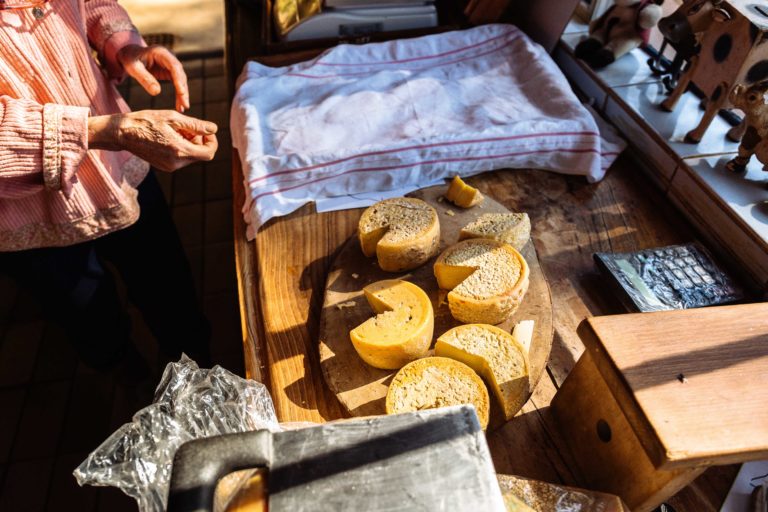
You can learn how to make organic cheese at Wegraakbosch (from R110 per person). Image credit: Mia Louw
When I asked Wynand to describe Tzaneen and its communities, he replied: ‘Supportive.’ And it’s evident – residents help each other. I noticed a similar trend at Wegraakbosch Dairy, which is community driven and off the grid. There was a festive atmosphere as we parked our car at this organic farm, half an hour outside Tzaneen towards Haenertsburg. We were welcomed by Sylvia and Nipper Thompson and their dogs; a duck waddled by and a group of school kids gathered around the dairy while cows leisurely strolled past. The children were on a cheesemaking tour so we joined in to learn about the process with hostess Gloria Mashaba and dairy expert Francisco Huo.
‘Did you have one of their cheese platters?’ Marinda asked eagerly back at Fairview. I did, and it was delightful – especially with the rustic outdoor seating and views over the farm. I sipped red wine and relished Mutschli, Emmental and Harvati cheeses.
There had been another festive gathering earlier in the year. Political heavyweights, royal delegates, church leaders and guests from abroad assembled for a ceremony to recognise the Balobedu Queenship, also known as the Rain Queen or the Modjadji. Twelve-year-old Masalanabo Modjadji will become Queen Modjadji the seventh, once she has graduated in the Lobedu custom.
Locals are proud of this history and the small Modjadji Cycad Nature Reserve is said to be protected by the rainmaking queens, who have inhabited the region since the 16th century. The reserve reputedly has the world’s largest concentration of a single-species cycad, the Modjadji palm. As we explored the walking trails that wind between these prehistoric plants, it seemed as if Modjadji greeted us with dense mist and a soft drizzle.
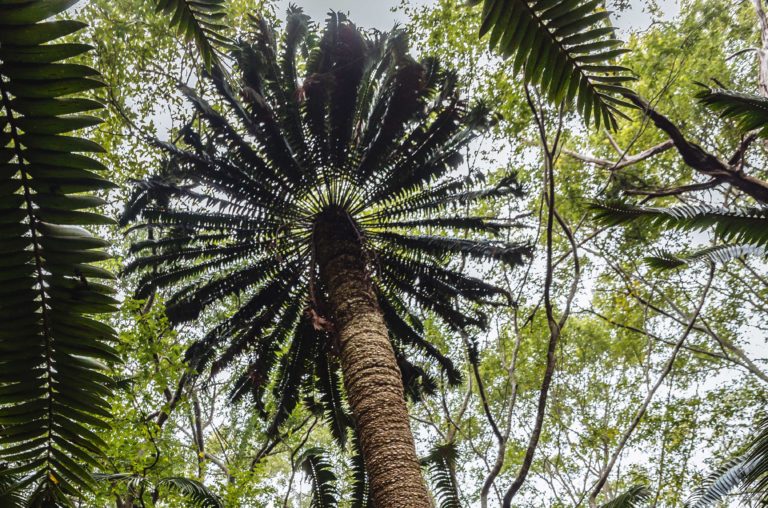
Visits to the royal kraal and accommodation in traditional huts can be arranged at the Modjadji Cycad Nature Reserve. Image credit: Mia Louw
I am grateful that Marinda and Andre insisted we visit the cycads; many attractions lie in a 35-kilometre radius of Tzaneen and are easy to miss if you don’t know the area.
‘When new people come to town, they often stay two extra days after chatting to us,’ Andre chuckled. We were discussing the name again, as I’d subsequently heard about another meaning.
‘Yes, the name has a few different connotations … another is gathering place,’ Andre explained.
He glanced at his wife. ‘Everyone has their own experience and interpretation,’ Marinda added, smiling. ‘As for me, it means abundance.’
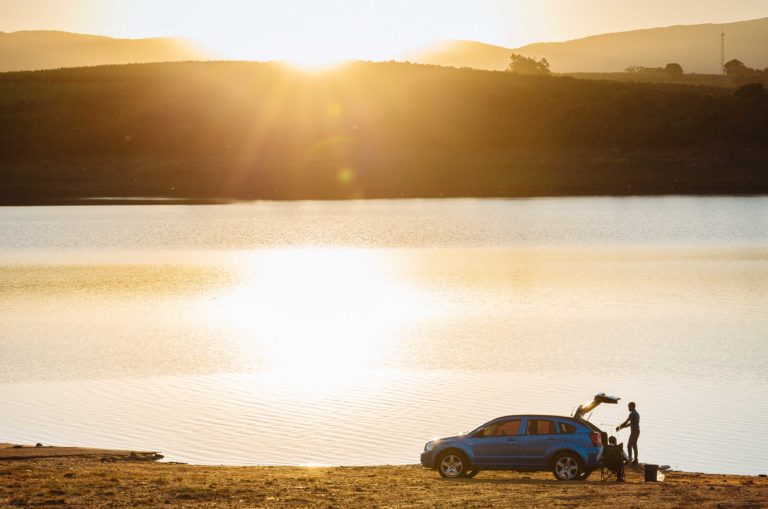
Tzaneen Dam is a favourite spot for fishing, and also has a 70-kilometre cycling route around it. Image credit: Mia Louw
Getting there
It’s 354km from Pretoria; take the N1 to Polokwane and the R71 via Haenertsburg and Magoebaskloof.
Stay here
The Fairview Collection is a 26ha estate with a choice of rooms, chalets, luxury suites and spa. From R880 per person sharing B&B. 0153072679, fairviewtzaneen.co.za
Granny Dot’s Country Spot overlooks the hills of the Agatha farming district. There are six double rooms, all with patios. R475 per person sharing B&B. 0153075149, grannydots.co.za
Christie’s Inn is a guest house in town, offering 10 en-suite rooms with views of the garden and pool. R595 per person sharing B&B. 0153060243, christiesinn.com
Do this
See African pole carvings at the Tzaneen Museum – it has a large collection and is crammed full of artefacts from the local Tsonga and North Sotho people. 0150040923
Enjoy a canopy tour over the Great Letaba River with Magoebaskloof Adventures. There are 11 zip lines (the longest at 150m), which zigzag down the river and over water- falls. R625 per person for two-and- a-half hours (other activities are available). 0838661546
Learn about monkeys at the non-profit Vervet Monkey Foundation, which rehabilitates and provides sanctuary for about 600 primates. There are tours, half- and full-day volunteering opportunities and weekend stays for volunteers. The tour is R100 for adults and R50 for kids. 0827259432
Visit nearby Haenertsburg (30km away) for shopping, dining and hiking. You’ll find more restaurants in this tiny hamlet’s main street than in the whole of Tzaneen. The Louis Changuion Hiking Trail (10km) starts and ends in Rissik Street. Maps are available at the Memory Hold-The-Door second-hand bookshop for free. 0795257849
Kings Walden Garden Manor
This historic garden and century-old guest house overlooks the Letsitele Valley and the Drakensberg. Its famous lightning tree (above) stands out – legend has it the blue-gum was struck on the same night the owner’s wife passed away. 0793967830
Modjadji Cycad Nature Reserve
Modjadji resembles a scene from Jurassic Park – some of the plants date back to the era of dinosaurs. Some cycads reach 13 metres, others grow in contorted clumps; the braai spots are enveloped by the flora. R20 per person. 0153117009
Champion baobab
The Sunland Baobab toppled over in 2017, but it’s still a worthwhile drive north of town to see it. The tree is more than 1 000 years old. Before it fell, its trunk circumference was 33,63 metres and it stood 19 metres tall. Visitor’s fee R25 per person. For a list of Champion Trees around Tzaneen, visit iinfo.co.za.
Eat here
The Tavern at Highgrove Lodge offers family friendly dining and a vibey bar next door. Check out the chef’s specials for pub-grub fare, such as eisbein and oxtail (R95 each). 0721505380
Monya’s Restaurant is fine dining meets chic bistro, while also catering for vegetarians. Pan-fried calamari steaks with basmati rice (R110) and meatball and mushroom penne pasta (R92). 0795004181
The Iron Crown is a pub and bistro in Haenertsburg. Try the Haenertsburger for R95 (with locally sourced ingredients) and Old Packhouse Distillery’s Blueberry, Valencia and Crystal gins, which are Amorentia’s side project. R25 for a shot. 0724249912









